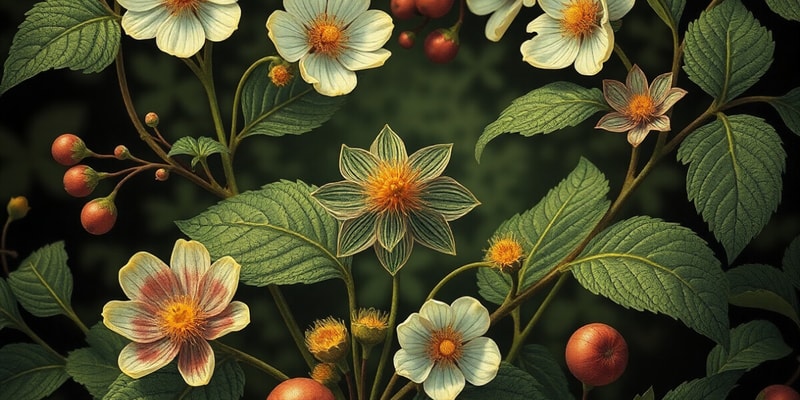Podcast
Questions and Answers
What defines animal-pollinated flowers?
What defines animal-pollinated flowers?
What is a common feature of wind-pollinated flowers?
What is a common feature of wind-pollinated flowers?
What is the main benefit of seeds growing far away from parent plants?
What is the main benefit of seeds growing far away from parent plants?
Which of the following characteristics applies to seeds dispersed by wind?
Which of the following characteristics applies to seeds dispersed by wind?
Signup and view all the answers
In the context of plant reproduction, what does fertilization specifically involve?
In the context of plant reproduction, what does fertilization specifically involve?
Signup and view all the answers
Which of the following is true about seeds dispersed by water?
Which of the following is true about seeds dispersed by water?
Signup and view all the answers
What is not a characteristic of pollen grains in animal-pollinated flowers?
What is not a characteristic of pollen grains in animal-pollinated flowers?
Signup and view all the answers
How do fruits dispersed by animals typically attract these creatures?
How do fruits dispersed by animals typically attract these creatures?
Signup and view all the answers
Study Notes
Plants Reproduction
- Pollination is the transfer of pollen grains from the anther to the stigma of a flower.
Animal-Pollinated Flowers vs. Wind-Pollinated Flowers
-
Animal-Pollinated Flowers:
- Brightly colored petals to attract animals
- Sweet scent and nectar
- Anthers and stigma inside flowers
- Heavier pollen grains with spikes to stick to animals
-
Wind-Pollinated Flowers:
- Small, dull colored or no petals
- No sweet scent or nectar
- Anthers and feathery stigma outside flower
- Light pollen grains with a smooth surface
Fertilization
- Fertilization is the fusion of male and female reproductive parts.
Seed Dispersal
-
Why do seeds need to grow away from parent plants?
- To prevent overcrowding and competition for resources like sunlight and water.
-
By Wind:
- Seeds are light and small
- Some have wing-like structures to stay in the air
- Examples: shorea, angsana, grass
-
By Water:
- Fruits have waterproof coverings or fibrous husks
- Float on water
- Examples: lotus, coconut, water lily
-
By Animal:
-
Fruits that attract animals:
- Colorful, sweet, fleshy/juicy fruits
- Animals disperse seeds when they eat the fruit or pass them out in their droppings
- Examples: mangoes, cherries, tomatoes
-
Fruits with sticky or hooked structures:
- Sticky or hooked fruits stick to animal fur to disperse the seed
- Examples: love grass, mimosa
-
Fruits that split open:
- Some split open as they ripen to disperse their seeds
- Others split open when the fruits dry to disperse the seeds
-
Fruits that attract animals:
Seed Germination and Growth
-
Seed parts:
- Seed coat
- Seed leaf
- Baby plant
-
Root growth:
- The root grows first and gets its food from the seed leaf.
-
Shoot growth:
- The shoot, with leaves, emerges and the plant develops to make its food
-
Seed leaf decrease:
- As the plant develops the seed leaves decrease in size
-
Growth into adult plant:
- The seedling grows into an adult plant that produces flowers.
Studying That Suits You
Use AI to generate personalized quizzes and flashcards to suit your learning preferences.
Related Documents
Description
Explore the fascinating world of plant reproduction, including the processes of pollination, fertilization, and seed dispersal. Learn about the differences between animal-pollinated and wind-pollinated flowers. This quiz will enhance your understanding of how plants reproduce and disperse their seeds.




